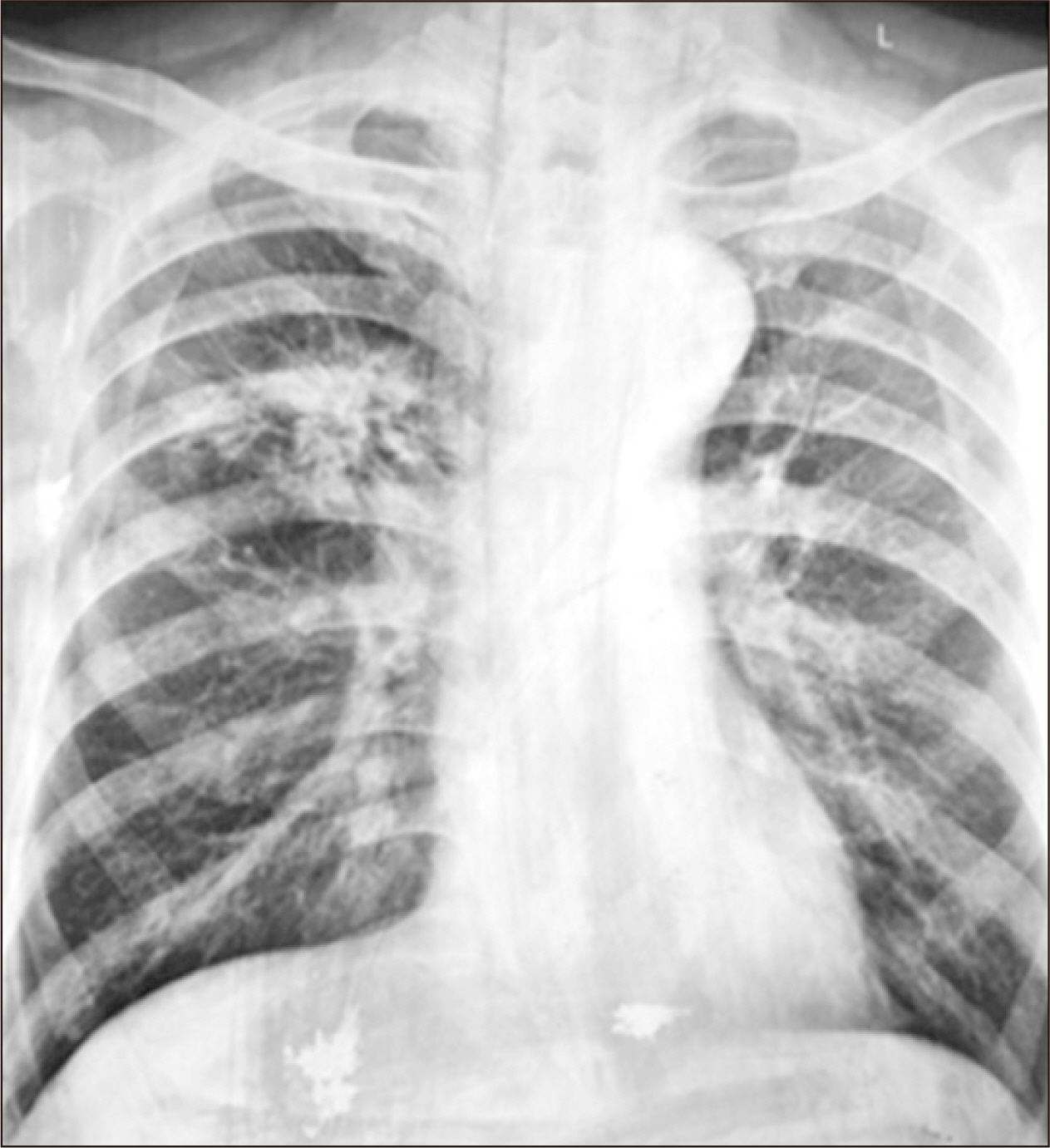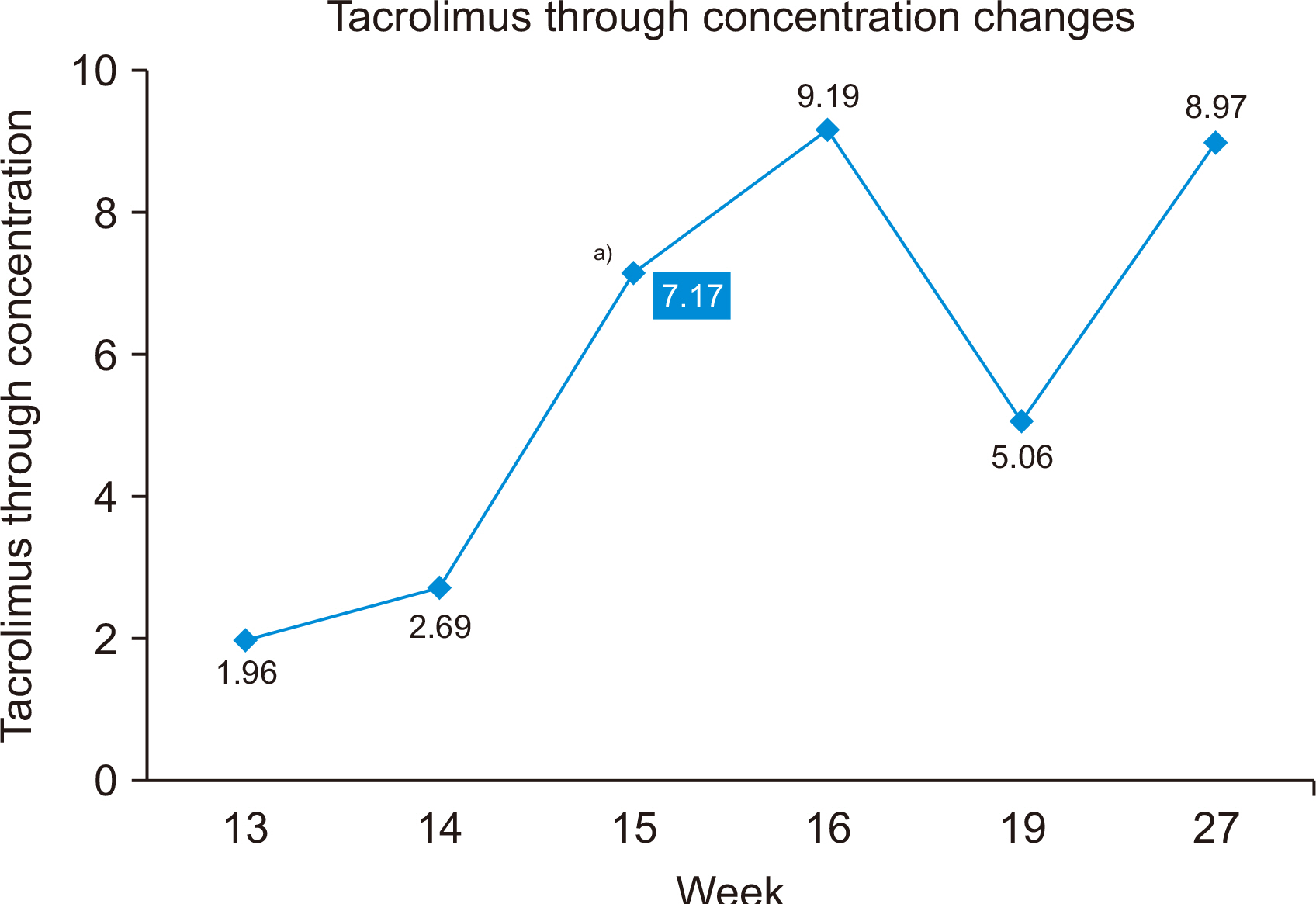Korean J Transplant.
2021 Mar;35(1):48-52. 10.4285/kjt.20.0041.
Posttransplantation tuberculosis management in terms of immunosuppressant cost: a case report in Myanmar
- Affiliations
-
- 1Department of Nephrology, University of Medicine, Mandalay, Mandalay, Myanmar
- 2Department of Pharmacology, University of Medicine, Mandalay, Mandalay, Myanmar
- 3Department of Nephrology, Mandalay General Hospital, Mandalay, Myanmar
- KMID: 2514408
- DOI: http://doi.org/10.4285/kjt.20.0041
Abstract
- Drug interactions between anti-tuberculosis and immunosuppressive medications after renal transplantation are a common problem in Myanmar. The efficacy of both types of drugs can be reduced during the treatment period, which can lead to graft failure and flare-ups of infection. Drug adjustments, with frequent monitoring and close follow-up, are crucial in this period. Ketoconazole decreases tacrolimus metabolism by inhibiting cytochrome P450-3A5 enzymes and P-glycoprotein. It is cost effective and has been frequently used to reduce the dose and cost of tacrolimus. Here, we report the case of a 56-year-old male renal transplant recipient with anti-tuberculosis medications.
Figure
Reference
-
1. Flynn JL, Chan J. 2001; Immunology of tuberculosis. Annu Rev Immunol. 19:93–129. DOI: 10.1146/annurev.immunol.19.1.93. PMID: 11244032.2. Kaufmann SH, Cole ST, Mizrahi V, Rubin E, Nathan C. 2005; Mycobacterium tuberculosis and the host response. J Exp Med. 201:1693–7. DOI: 10.1084/jem.20050842. PMID: 15939785. PMCID: PMC2213264.
Article3. Anand M, Nayyar E, Concepcion B, Salani M, Schaefer H. 2017; Tuberculosis in kidney transplant recipients: a case series. World J Transplant. 7:213–21. DOI: 10.5500/wjt.v7.i3.213. PMID: 28698838. PMCID: PMC5487311.
Article4. Zhang R. 2013; Modern immunosuppressive therapy in kidney transplantation. Open J Organ Transpl Surg. 3:22–31. DOI: 10.4236/ojots.2013.32005.5. Lemahieu WP, Maes BD, Verbeke K, Vanrenterghem Y. 2004; CYP3A4 and P-glycoprotein activity in healthy controls and transplant patients on cyclosporin vs. tacrolimus vs. sirolimus. Am J Transplant. 4:1514–22. DOI: 10.1111/j.1600-6143.2004.00539.x. PMID: 15307840.
Article6. Scholten EM, Cremers SC, Schoemaker RC, Rowshani AT, van Kan EJ, den Hartigh J, et al. 2005; AUC-guided dosing of tacrolimus prevents progressive systemic overexposure in renal transplant recipients. Kidney Int. 67:2440–7. DOI: 10.1111/j.1523-1755.2005.00352.x. PMID: 15882290.
Article7. el-Dahshan KF, Bakr MA, Donia AF, Badr Ael-S, Sobh MA. 2004; Co-administration of ketoconazole to tacrolimus-treated kidney transplant recipients: a prospective randomized study. Nephrol Dial Transplant. 19:1613–7. DOI: 10.1093/ndt/gfh191. PMID: 15034161.
Article8. El-Dahshan KF, Bakr MA, Donia AF, Badr Ael-S, Sobh MA. 2006; Ketoconazole-tacrolimus coadministration in kidney transplant recipients: two-year results of a prospective randomized study. Am J Nephrol. 26:293–8. DOI: 10.1159/000094133. PMID: 16804292.
Article9. Subramanian AK, Morris MI. AST Infectious Diseases Community of Practice. 2013; Mycobacterium tuberculosis infections in solid organ transplantation. Am J Transplant. 13 Suppl 4:68–76. DOI: 10.1111/ajt.12100. PMID: 23465000.10. Chen CH, Lian JD, Cheng CH, Wu MJ, Lee WC, Shu KH. 2006; Mycobacterium tuberculosis infection following renal transplantation in Taiwan. Transpl Infect Dis. 8:148–56. DOI: 10.1111/j.1399-3062.2006.00147.x. PMID: 16913973.
Article11. Melchor JL, Gracida C, Ibarra A. 2002; Increased frequency of tuberculosis in Mexican renal transplant recipients: a single-center experience. Transplant Proc. 34:78–9. DOI: 10.1016/S0041-1345(01)02674-4. PMID: 11959194.
Article12. Marques ID, Azevedo LS, Pierrotti LC, Caires RA, Sato VA, Carmo LP, et al. 2013; Clinical features and outcomes of tuberculosis in kidney transplant recipients in Brazil: a report of the last decade. Clin Transplant. 27:E169–76. DOI: 10.1111/ctr.12077. PMID: 23351041.
Article13. Walsh R, Ortiz J, Foster P, Palma-Vargas J, Rosenblatt S, Wright F. 2008; Fungal and mycobacterial infections after Campath (alemtuzumab) induction for renal transplantation. Transpl Infect Dis. 10:236–9. DOI: 10.1111/j.1399-3062.2007.00292.x. PMID: 18086280.
Article14. Finch CK, Chrisman CR, Baciewicz AM, Self TH. 2002; Rifampin and rifabutin drug interactions: an update. Arch Intern Med. 162:985–92. DOI: 10.1001/archinte.162.9.985. PMID: 11996607.15. Sundaram M, Adhikary SD, John GT, Kekre NS. 2008; Tuberculosis in renal transplant recipients. Indian J Urol. 24:396–400. DOI: 10.4103/0970-1591.42625. PMID: 19468476. PMCID: PMC2684355.
Article
- Full Text Links
- Actions
-
Cited
- CITED
-
- Close
- Share
- Similar articles
-
- Current Status of Standard Diagnostics and Treatment for Malaria, Tuberculosis, and Hepatitis in Myanmar
- Epstein-Barr Virus Related Polymorphic Posttransplantation Lymphoproliferative Disease in a Patient with Latent Infection of JC Virus
- Dawn of Theranostics in Myanmar (Dream, Reality, and Constraint)
- A Report of Participation in WHO Seminar on Tuberculosis Management
- Phenotypic and Genotypic Analysis of Anti-Tuberculosis Drug Resistance in Mycobacterium tuberculosis Isolates in Myanmar





